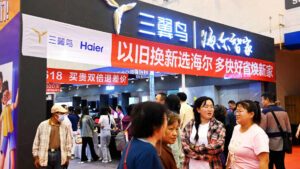Are China’s Trade-in Policies Boosting Consumption?
China recently announced a plan to allocate 300 billion yuan ($41.5 billion) to expand its trade-in and equipment upgrade policy in an effort to boost consumption. This move aims to subsidize trade-ins of larger consumer goods like cars and home appliances, as well as upgrades for large equipment such as elevators. While this targeted approach surprised analysts, the effectiveness of these measures remains to be seen.
At Extreme Investor Network, we understand the importance of staying informed about global economic policies and their impact on investments. China’s trade-in program may provide opportunities for investors, but it’s essential to analyze the potential outcomes carefully.
According to Jens Eskelund, president of the EU Chamber of Commerce in China, there hasn’t been a significant translation of these measures into concrete incentives on the ground. This calls for a closer look at execution for tangible results.
UBS Investment Bank Chief China Economist Tao Wang suggested that the trade-in program could support a small percentage of retail sales, with uncertainty about its overall impact. At Extreme Investor Network, we analyze market trends and insights to help investors make informed decisions in uncertain times.
As China continues to roll out policies supporting equipment upgrades and consumer trade-ins, it’s crucial to monitor how these programs evolve and their implications on the market. Businesses like Otis and Kone are optimistic about the potential opportunities these policies present, but there are still uncertainties about the timeline of their implementation.
As experts in finance and investment, Extreme Investor Network provides unique insights and analysis on global economic trends. Keep an eye on our website for more updates on China’s trade-in policies and other market developments that could impact your investment strategy.

